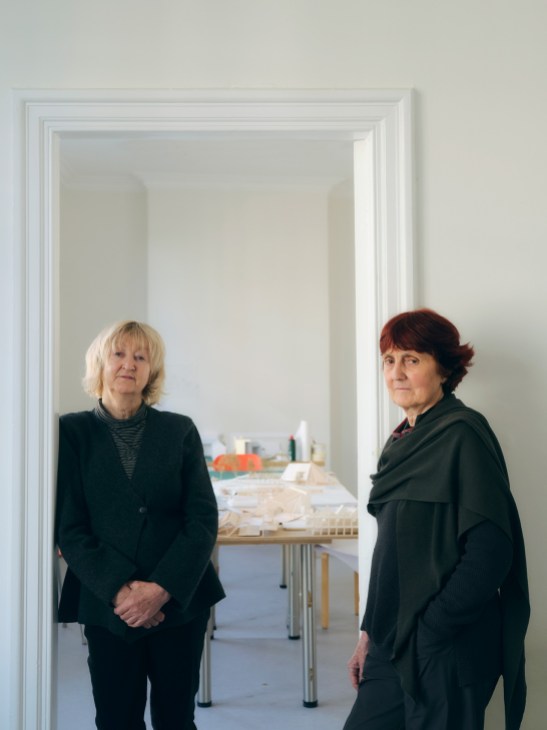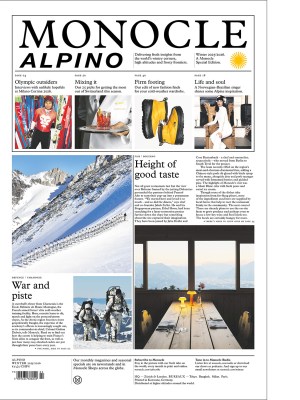The architecture of empathy: Yvonne Farrell and Shelley McNamara on building for communities
Grafton Architects’ co-founders on designing buildings that balance authenticity, social impact and architectural excellence.
Soon after graduating from University College Dublin in 1974, Yvonne Farrell and Shelley McNamara began teaching architecture at their alma mater and, shortly after, co-founded Grafton Architects on the Dublin street of the same name. In the first few decades of their practice, they predominantly worked on projects in their homeland, from schools to public housing, but a competition to design a lecture hall at Università Luigi Bocconi in Milan (completed 2008), launched them onto the global stage. They have now worked in cities from Lima to London. Additionally, they have curated the Venice Biennale’s International Architecture Exhibition (2018), picked up a World Building of the Year award and were awarded the Pritzker Prize in 2020.
When Monocle visits their studio, models and maquettes are being prepared for competition entries and team members are poring over drawings. Awards and trophies, from Silver Lions to Prix de l’Équerre d’Argent, are set on shelves. Despite the accolades, the duo remain committed to building with clients and communities in mind. “Architecture, whether it’s a door or a huge campus, has the capacity to be everything,” says Farrell. “If it’s done properly, it’s a gift to humanity. And if it’s an afterthought, it’s absolutely horrible because it affects everybody’s life.”

How did your early life shape your desire to work in architecture?
Yvonne Farrell: I grew up in Tullamore in the middle of Ireland. It was a small place but it had a public swimming pool, which was unusual for an Irish town at the time. Every child would cycle to it in summer. I saw a freedom in having that generous public infrastructure. That’s why architecture is amazing: it’s building the world. It’s misunderstood as a discipline, with people seeing it as a series of Taj Mahals instead of the infrastructural web that makes community possible. Shelley and I talk about it as built skin.
Shelley McNamara: I grew up in Lisdoonvarna, a spa town in County Clare. For a month every year, I would watch farmers come after the harvest to have their sulphur baths and massages. What I loved about it was that all ages and income groups would use the same place in the same way. It shaped my views. I saw the mixing of people in towns and cities as the secret that brings an exchange of energy that everyone benefits from. Architecture provides the framework for this.
Tell us about your approach to practice.
YF: For us, one of the lovely components of architecture is that it’s a social and cultural responsibility, where the work is usually initiated by the client. You don’t go off and think up a design irrespective of the people who commission you. Instead, they come with their hard-earned money and say, “Can you translate my words – the brief, the list of needs and requirements – into space? And can that space have some cultural value?”
SM: We start by trying to articulate how a space might feel, not how it’s organised. With the Anthony Timberlands Center for Design and Materials Innovation at the University of Arkansas, for instance, we loved the idea of creating a big hall, in the form of a workshop, as the heart of the space. The result is a beehive of activity where you’re never separated from the process of making.
How important is it for your projects to have a strong sense of place?
YF: It’s about cultural continuity, which is what anchors us in the world. If you’re not connected with your culture, you’re floating. Even nomadic people have a home. It might not be a physical one – maybe it’s a memory, a person or a thing. We need to consider the geological and landscape aspects of culture too. That might be remembering that there’s a breeze from the ocean that a contemporary work could possibly absorb.
SM: The interesting thing about this outlook is that there isn’t just a building and then culture – there’s an interconnectedness of it all at multiple levels.
How can a work of architecture reflect this view?
SM: One of our projects that captures this is the headquarters that we designed for the Dublin Electricity Supply Board. It was on a site where Georgian-era townhouses had been knocked down in the 1960s. People were very sensitive about their loss. Our design embedded a new tiered structure along the street, with façades at the same height as the original streetscape, referencing the original language of that part of the city. The question was how to make something authentic that’s also directly linked to the past. We found the answer by learning from an Italian architect about how to make a beautiful door and steps that feel as though they’re from the 18th century, referencing the doorways that were once there. The key to this was being true to the craft – making real brick walls and not brick cladding like so many buildings.
YF: Architecture is a spectrum of good, ordinary and, sometimes, gorgeous. It’s important to remember this – and that there’s a place for it all. There is, for instance, a spectrum of decent housing. You can have a lovely place to live with a terrace looking out over a beautiful bay or an ordinary, light-filled home within walking distance to a good school. You can look at it in the same sort of way as you would the joy of fiction: you can read The Grapes of Wrath or poet Eavan Boland’s work. It’s like that with architecture.


